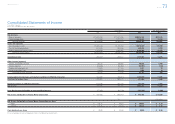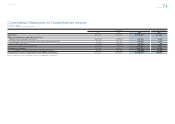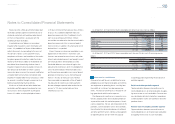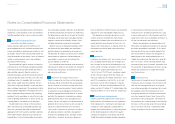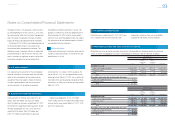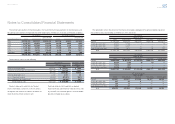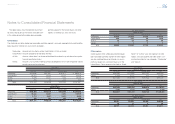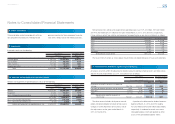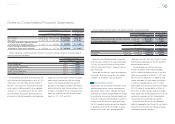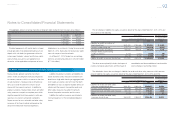Toyota 2013 Annual Report Download - page 82
Download and view the complete annual report
Please find page 82 of the 2013 Toyota annual report below. You can navigate through the pages in the report by either clicking on the pages listed below, or by using the keyword search tool below to find specific information within the annual report.
Toyota Global Vision President’s Message Launching a New Structure Special Feature Review of Operations
Consolidated Performance
Highlights
Management and
Corporate Information Investor InformationFinancial Section
Page 82
NextPrev
ContentsSearchPrint
ANNUAL REPORT 2013
Goodwill and intangible assets
Goodwill is not material to Toyota’s consolidated
balance sheets.
Intangible assets consist mainly of software.
Intangible assets with a defi nite life are amortized on
a straight-line basis with estimated useful lives
mainly of 5 years. Intangible assets with an indefi nite
life are tested for impairment whenever events or
circumstances indicate that a carrying amount of an
asset (asset group) may not be recoverable.
An impairment loss would be recognized when
the carrying amount of an asset exceeds the esti-
mated undiscounted cash fl ows used in determining
the fair value of the asset. The amount of the impair-
ment loss to be recorded is generally determined by
the difference between the fair value of the asset
using a discounted cash fl ow valuation method and
the current book value.
Employee benefi t obligations
Toyota has both defi ned benefi t and defi ned contri-
bution plans for employees’ retirement benefi ts.
Retirement benefi t obligations are measured by
actuarial calculations in accordance with U.S. GAAP.
The funded status of the defi ned benefi t postretire-
ment plans is recognized on the consolidated bal-
ance sheets as prepaid pension and severance costs
or accrued pension and severance costs, and the
funded status change is recognized in the year in
which it occurs through other comprehensive income.
Environmental matters
Environmental expenditures relating to current oper-
ations are expensed or capitalized as appropriate.
rates. All derivative fi nancial instruments are record-
ed on the consolidated balance sheets at fair value,
taking into consideration the effects of legally
enforceable master netting agreements that allow
us to net settle positive and negative positions and
offset cash collateral held with the same counter-
party on a net basis. Toyota does not use deriva-
tives for speculation or trading purposes. Changes
in the fair value of derivatives are recorded each
period in current earnings or through other compre-
hensive income, depending on whether a derivative
is designated as part of a hedge transaction and the
type of hedge transaction. The ineffective portion of
all hedges is recognized currently in operations.
Net income attributable to Toyota Motor
Corporation per share
Basic net income attributable to Toyota Motor
Corporation per common share is calculated by
dividing net income attributable to Toyota Motor
Corporation by the weighted-average number of
shares outstanding during the reported period.
The calculation of diluted net income attributable
to Toyota Motor Corporation per common share
is similar to the calculation of basic net income
attributable to Toyota Motor Corporation per share,
except that the weighted-average number of shares
outstanding includes the additional dilution from the
assumed exercise of dilutive stock options.
Stock-based compensation
Toyota measures compensation expense for its stock-
based compensation plan based on the grant-date fair
value of the award, and accounts for the award.
Expenditures relating to existing conditions caused
by past operations, which do not contribute to cur-
rent or future revenues, are expensed. Liabilities for
remediation costs are recorded when they are prob-
able and reasonably estimable, generally no later
than the completion of feasibility studies or Toyota’s
commitment to a plan of action. The cost of each
environmental liability is estimated by using current
technology available and various engineering, fi nan-
cial and legal specialists within Toyota based on
current law. Such liabilities do not refl ect any offset
for possible recoveries from insurance companies
and are not discounted. There were no material
changes in these liabilities for all periods presented.
Income taxes
The provision for income taxes is computed based
on the pretax income included in the consolidated
statements of income. The asset and liability
approach is used to recognize deferred tax assets
and liabilities for the expected future tax conse-
quences of temporary differences between the car-
rying amounts and the tax bases of assets and
liabilities. Valuation allowances are recorded to
reduce deferred tax assets when it is more likely
than not that a tax benefi t will not be realized.
Derivative fi nancial instruments
Toyota employs derivative fi nancial instruments,
including forward foreign currency exchange con-
tracts, foreign currency options, interest rate swaps,
interest rate currency swap agreements and interest
rate options to manage its exposure to fl uctuations
in interest rates and foreign currency exchange
Other comprehensive income
Other comprehensive income refers to revenues,
expenses, gains and losses that, under U.S. GAAP
are included in comprehensive income, but are
excluded from net income as these amounts are
recorded directly as an adjustment to shareholders’
equity. Toyota’s other comprehensive income is pri-
marily comprised of unrealized gains/losses on mar-
ketable securities designated as available-for-sale,
foreign currency translation adjustments and adjust-
ments attributed to pension liabilities associated
with Toyota’s defi ned benefi t pension plans.
Accounting changes
In June 2011, FASB issued updated guidance on
the presentation of comprehensive income. This
guidance requires to present the total of compre-
hensive income, the components of net income,
and the components of other comprehensive
income either in a single continuous statements of
comprehensive income or in two separate but con-
secutive statements. Toyota adopted this guidance
from the interim period within the fi scal year, begun
after December 15, 2011. The adoption of this
guidance did not have a material impact on Toyota’s
consolidated fi nancial statements.
Recent pronouncements to be adopted in
future periods
In December 2011, FASB issued updated guidance
of disclosures about offsetting assets and liabilities.
This guidance requires additional disclosures about
gross and net information for assets and liabilities
including fi nancial instruments eligible for offset in
Notes to Consolidated Financial Statements
Selected Financial Summary (U.S. GAAP) Consolidated Segment Information Consolidated Quarterly Financial Summary Management’s Discussion and Analysis of Financial Condition and Results of Operations Consolidated Financial Statements Notes to Consolidated Financial Statements [5 of 44]
Management’s Annual Report on Internal Control over Financial Reporting Report of Independent Registered Public Accounting Firm



